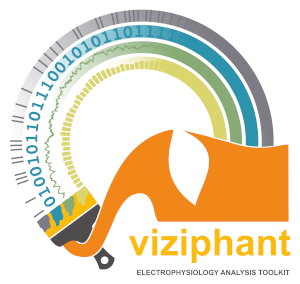viziphant.unitary_event_analysis.plot_ue¶
- viziphant.unitary_event_analysis.plot_ue(spiketrains, Js_dict, significance_level=0.05, **plot_params)[source]¶
Plots the results of pairwise unitary event analysis as a column of six subplots, comprised of raster plot, peri-stimulus time histogram, coincident event plot, coincidence rate plot, significance plot and unitary event plot, respectively.
- Parameters:
- spiketrainslist of list of neo.SpikeTrain
A nested list of trials, neurons and their neo.SpikeTrain objects, respectively. This should be identical to the one used to generate Js_dict.
- Js_dictdict
The output of
elephant.unitary_event_analysis.jointJ_window_analysis()function. The values of each key has the shape of:different window –> 0-axis.
different pattern hash –> 1-axis;
Dictionary keys:
- ‘Js’: list of float
JointSurprise of different given patterns within each window.
- ‘indices’: list of list of int
A list of indices of pattern within each window.
- ‘n_emp’: list of int
The empirical number of each observed pattern.
- ‘n_exp’: list of float
The expected number of each pattern.
- ‘rate_avg’: list of float
The average firing rate of each neuron.
- significance_levelfloat
The significance threshold used to determine which coincident events are classified as unitary events within a window.
- **plot_params
User-defined plotting parameters used to update the default plotting parameter values. The valid keys:
- ‘events’dict
Epochs to be marked on the time axis.
- ‘figsize’tuple of int
The dimensions for the figure size.
- ‘right’float
The size of the right margin.
- ‘top’float
The size of the top margin.
- ‘bottom’float
The size of the bottom margin.
- ‘left’float
The size of the left margin.
- ‘hspace’flaot
The size of the horizontal white space between subplots.
- ‘wspace’float
The width of the white space between subplots.
- ‘fsize’int
The size of the font.
- ‘unit_real_ids’list of int
The unit ids from the experimental recording.
- ‘lw’int
The default line width.
- ‘ms’int
The marker size for the unitary events and coincidences.
- Returns:
- resultFigureUE
The container for Axes objects generated by the function. Individual axes can be accessed using the following identifiers:
axes_spike_events : matplotlib.axes.Axes
Contains the elements of the spike events subplot.
axes_spike_rates : matplotlib.axes.Axes
Contains the elements of the spike rates subplot.
axes_coincident_events : matplotlib.axes.Axes
Contains the elements of the coincident events subplot.
axes_coincidence_rates : matplotlib.axes.Axes
Contains the elements of the coincidence rates subplot.
axes_significance : matplotlib.axes.Axes
Contains the elements of the statistical significance subplot.
axes_unitary_events : matplotlib.axes.Axes
Contains the elements of the unitary events subplot.
Examples
Unitary Events of homogenous Poisson random processes.
Since we don’t expect to find significant correlations in random processes, we show non-significant events (
significance_level=0.34). Typically, in your analyses, the significant level threshold is ~0.05.import matplotlib.pyplot as plt import numpy as np import quantities as pq import viziphant from elephant.spike_train_generation import homogeneous_poisson_process from elephant.unitary_event_analysis import jointJ_window_analysis np.random.seed(10) spiketrains1 = [homogeneous_poisson_process(rate=20 * pq.Hz, t_stop=2 * pq.s) for _ in range(5)] spiketrains2 = [homogeneous_poisson_process(rate=50 * pq.Hz, t_stop=2 * pq.s) for _ in range(5)] spiketrains = np.stack((spiketrains1, spiketrains2), axis=1) ue_dict = jointJ_window_analysis(spiketrains, bin_size=5 * pq.ms, win_size=100 * pq.ms, win_step=10 * pq.ms) viziphant.unitary_event_analysis.plot_ue(spiketrains, Js_dict=ue_dict, significance_level=0.34, unit_real_ids=['1', '2']) plt.show()
Refer to UEA Tutorial for real-case scenario.
